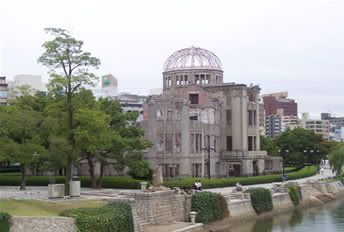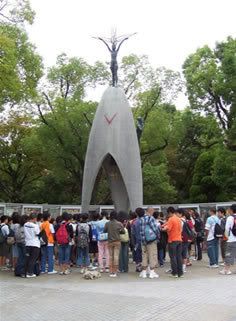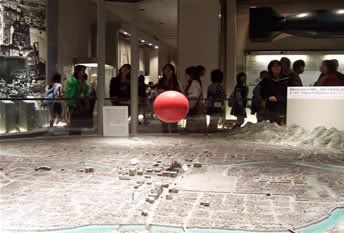The A-Bomb Dome, Hiroshima
I don`t think it`s possible to enjoy a trip to Hiroshima, unless you deliberately avoid any atomic-bomb related sites. You could just treat it as a vibrant, busy city and spend time in the shops, parks and galleries. But, of course, sadly Hiroshima is far more than that. As long as we have a recorded history the city will be associated with one awful moment on the 6th August, 1945. At 8:30am an American bomber dropped the first nuclear weapon ever used in wartime, aiming for the distinctive T-shaped Aioi-bashi bridge in the west of the city. They only just missed - the bomb detonated a few hundred metres to the south-west, at about 500m off the ground. Directly underneath was the three-story Industrial Promotion Hall, a lrage domed building by the river. Everyone inside was incinerated immediately, but the ruined structure somehow survived. Renamed the A-Bomb Dome, it was left as it was to remind people of the destruction of the attack. It was our first port of call, and a sobering introduction considering what was to come.
The memorial to Sadako
Over the river is Peace Memorial Park - a once-busy residential area on a triangular island. Almost totally obliterated in the fireball, today it is full of trees and memorials to the people that died there. 25,000 Korean POW`s were imprisoned near the river when the bomb exploded. They were all killed, and there is a memorial to them - only recently relocated from an out of the way location. We saw children praying to the memorial to Sadako - a 10yr old girl who survived the blast only to develop leukaemia. She started folding paper cranes in the belief that if she folded 1000, she would be cured (the crane being the symbol of longevity). She died before she could complete them, but her classmates folded the rest for her.
Model of the size of the Hiroshima atomic fireball
Children were everywhere in Hiroshima. Like Miyajima the day before, there were hordes of kids in matching uniforms all being marched around by teachers. Inside the Peace Memorial Museum they were everywhere, acting pretty much like kids on school trips anywhere. Of course, this wasn`t anywhere, this was a museum depicting the effects of a nuclear holocaust. It was without doubt the most harrowing thing I`ve ever seen. From the detailed series of meetings taken by Allied leaders to select a bomb site (Churchill wanted to drop one on Germany, but the Americans persuaded him that the risk of the Nazis obtaining the secrets of the bomb if it failed to go off were too great to risk, so Japan was chosen), to the model and photographs of the aftermath, it was just awful. But it`s something that you need to see. Everyone should be made to go there - especially world leaders. The pitiful sight of scraps of blackened clothing next to photographs of real children were too much for me. Stories of kids setting out for school on a normal day only to be atomised without warning are bad enough - but when there are photos of those young children with a solitary belt buckle or charred tricycle it becomes too much. But it really does its job - it convinces you (if you needed any convincing) how awful nuclear weapons are, and how awful war is. I just wished the schoolkids who were there had paid more attention - but then the thought of being caught up in that horrific scenario is as remote for them as it would have been to those children setting out for school on the 6th of August, 1945.